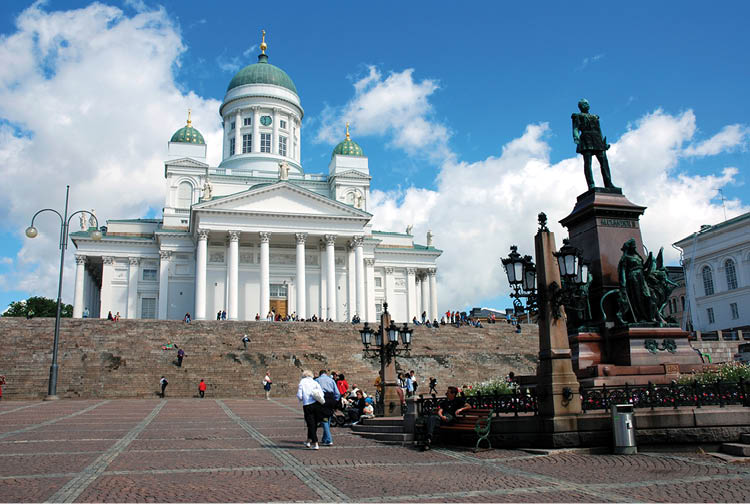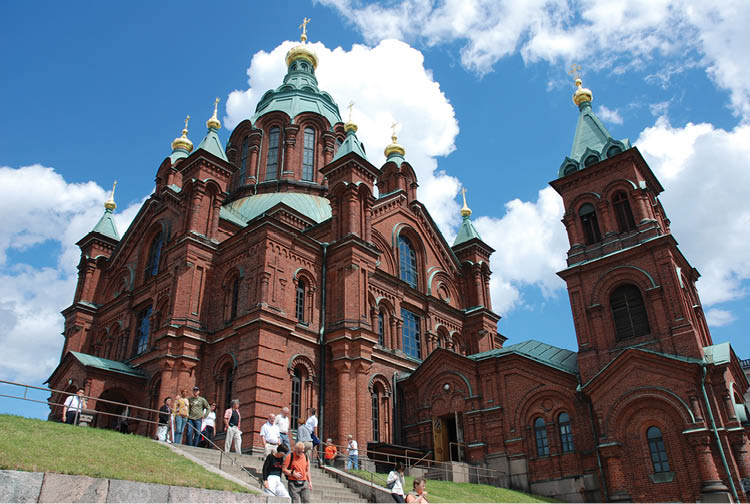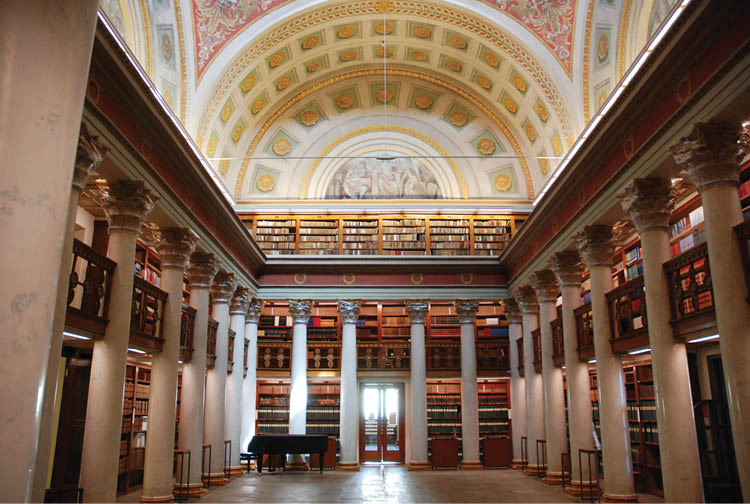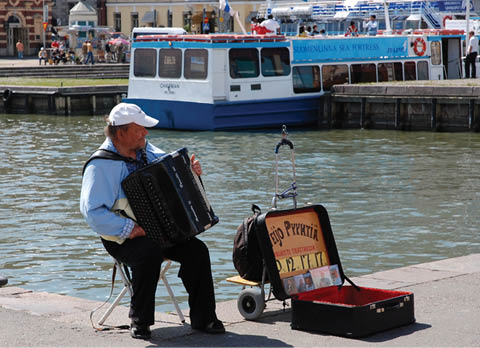Finland


Helsinki Cathedral overlooks Senate Square.
Finland has long been caught in the middle – between the warring empires of Sweden and Russia, then between the West and the Soviet Union. This political predicament has shaped much of Finland’s national character, as has the predominance of winter ice and snow. Ice skating originated in Finland when the early settlers strapped blades to their boots for crossing the frozen lakes that dot the countryside. Cross-country skiing is popular on the country’s vast central plateau of lakes and pine forests, where Finnish regiments fought the invading Soviets on skis during World War II. The heartiest of Finns practise the extreme sport of ice swimming – leaping into a hole (an avantouinti) that has been cut in the ice. The sauna has long been a popular family pastime in Finland, where the stones of a steaming hot sauna were traditionally heated with wood fires.
Finland’s northernmost area lies above the Arctic Circle where the Sami people inhabit the treeless tundra, their distant ancestors having arrived in Finland during prehistoric times. When nomadic Finnish-speaking hunters and fishers began migrating into the region, they pushed the Sami and their reindeer herds northward. Christian missionaries were the next to arrive, followed by Swedish troops in the 13th century. In 1581, Finland became a grand duchy of Sweden, enjoying extensive independence under Swedish rule while widely adopting the language and culture of the Swedes. Sweden’s recurring wars with Russia caused much suffering in Finland, however, including the famine of 1696 in which a third of the Finnish people perished.
Map of Finland

When Russia gained control of Finland during the Napoleonic Wars, the Finns began to chafe under foreign rule. Nationalism became a powerful movement, inspired initially by the epic poems of Johan Runeberg, and later by the stirring orchestral works of Jean Sibelius, who composed Finlandia in 1900 at a time when the democratic autonomy Finland had once enjoyed under Czar Alexander II was being curtailed by the imperial decrees of Czar Nicholas II. When the Bolsheviks deposed Nicholas during the Russian Revolution, Finland proclaimed its independence. In the ensuing civil war, the Finnish-nationalist White Guard – led by General Mannerheim – defeated the Soviet-backed Red Guard. Finland was not totally free of Russian dominance, however, for the Soviet Union attacked again in 1939. Finnish troops were superior at winter warfare and, aided by volunteers and supplies from Sweden and Norway, were able to initially repulse the Russians. However, Finland was ultimately no match for the USSR and was forced to sign a peace treaty in early 1940.

Uspenski Orthodox Cathedral is the largest Eastern Orthodox church in Western Europe.
When Germany attacked the Soviet Union in June of 1941, Finland allied itself with Germany in an attempt to regain territory seized by the Soviets. By the end of the war, Finland was again the loser. Its northern region had been devastated by fighting between German and Soviet troops, and its shattered economy was burdened with $300 million in reparations owed to the USSR. Still, Finland managed to repay this heavy debt by 1952 and, despite Soviet influence on domestic politics, the Finnish-Communist Party gradually lost influence in the 1970s. However, Finland’s reluctance to provoke the communist superpower living next door resulted in what was dubbed the Finlandisation of the country in which the media, schools and libraries censored any material critical of the USSR.
The collapse of the Soviet Union in 1989 allowed Finland to become increasingly European, and the country has thrived as a highly industrialized, free-market economy. Finland, which joined the European Union in 1995, is admired for its high quality of public education and social welfare, which includes giving all expectant mothers a “baby box” filled with clothes, diapers and bathing products, and fitted with a small mattress so the box can be used as baby’s first bed. This tradition began in the 1930s when Finland was a poor country and was designed to give all children a good start in life.
The population of Finland is 5.2 million, and the majority (94%) speak Finnish – a language similar to Estonian and Hungarian. The Finnish language is unrelated to the North Germanic languages spoken in the rest of Scandinavia and relies heavily on the use of suffixes and compounds. Spoken by the peasantry under Swedish rule, the Finnish language received official status in 1863. Swedish, once the language of Finland’s nobility, is spoken by 6% of the populace and is Finland’s second official language. Street signs are posted in Finnish and Swedish. About 60% of Finns understand English.

Finland’s National Library is a repository of the nation’s literary heritage, including books published in the Russian Empire.
Following centuries of rule by Swedish kings and Russian czars, the modern nation of Finland – after fighting its way to independence in 1917 – chose not to adopt a monarch as head of state but instead became a parliamentary republic headed by a president. The majority of Finns (80%) belong to the Lutheran church, with 1% belonging to the Eastern Orthodox Church.
The unit of currency in Finland is the euro. The country calling code is +358.

A busker on Helsinki’s harbourfront.
Helsinki, situated on a peninsula, is a natural sea port and the capital of Finland. Founded in 1550 by Gustavus I of Sweden, the port (which is blocked by ice in winter) is sheltered by a group of islands upon which the Swedes constructed a sea fortress to defend its eastern frontier from Russian naval attacks.
Helsinki was destroyed by fire in 1808 and rebuilt on a grand scale after Czar Alexander I moved the Finnish capital there in 1812 from Turku. Helsinki hosted the 1952 Summer Olympic Games and in 1975 the Helsinki Conference on Security and Cooperation in Europe, which achieved the signing of the Helsinki Accords.

A waitress in a Helsinki restaurant.
Helsinki, with a population of 1.2 million, is the cultural heart of Finland. The city contains dozens of museums and art galleries, and enjoys a thriving café culture. It is also the nation’s commercial centre, with industries ranging from textile mills and clothing factories to machine shops and shipyards that build cruise ships, naval vessels and ice breakers. The famous Kvaerner Masa shipyard (which has launched numerous cruise ships) is located a short distance from the cruise piers at Hernesaari.